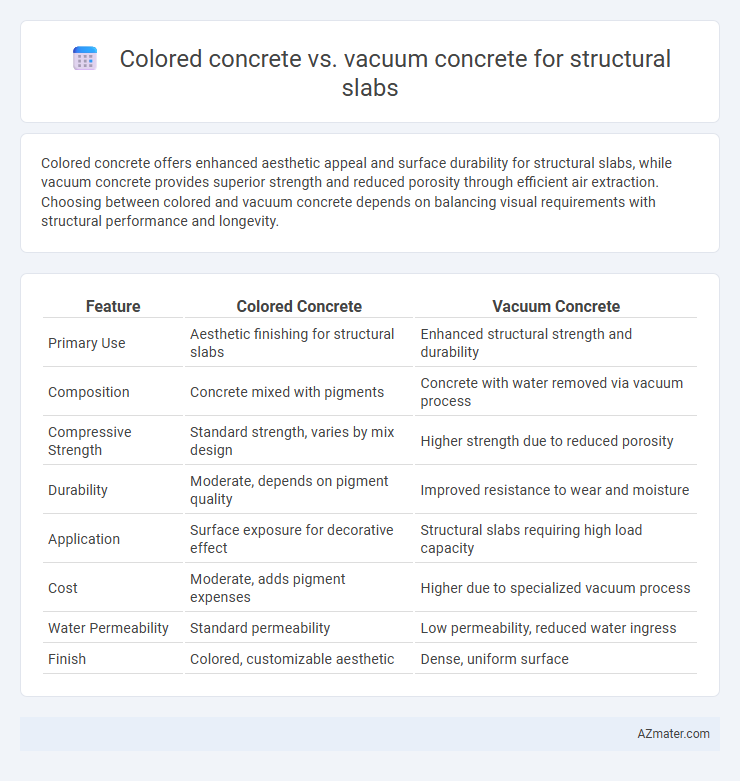Colored concrete offers enhanced aesthetic appeal and surface durability for structural slabs, while vacuum concrete provides superior strength and reduced porosity through efficient air extraction. Choosing between colored and vacuum concrete depends on balancing visual requirements with structural performance and longevity.
Table of Comparison
| Feature | Colored Concrete | Vacuum Concrete |
|---|---|---|
| Primary Use | Aesthetic finishing for structural slabs | Enhanced structural strength and durability |
| Composition | Concrete mixed with pigments | Concrete with water removed via vacuum process |
| Compressive Strength | Standard strength, varies by mix design | Higher strength due to reduced porosity |
| Durability | Moderate, depends on pigment quality | Improved resistance to wear and moisture |
| Application | Surface exposure for decorative effect | Structural slabs requiring high load capacity |
| Cost | Moderate, adds pigment expenses | Higher due to specialized vacuum process |
| Water Permeability | Standard permeability | Low permeability, reduced water ingress |
| Finish | Colored, customizable aesthetic | Dense, uniform surface |
Introduction to Structural Slab Concrete Types
Structural slab concrete types vary in composition and application, with colored concrete offering aesthetic customization through integral pigments that enhance surface appearance without compromising strength. Vacuum concrete, also known as vacuum dewatering concrete, improves compressive strength and durability by removing excess water from the mix shortly after placement, leading to denser slabs with reduced porosity. Selecting between colored and vacuum concrete depends on project requirements for visual appeal and structural performance in slab construction.
What is Colored Concrete?
Colored concrete is a type of concrete that incorporates pigments or dyes to achieve a specific color, enhancing aesthetic appeal while maintaining structural integrity for slabs. This variation allows for customization in architectural design, making it ideal for decorative floors and structural slabs requiring visual distinction. The pigments used in colored concrete are typically integrated during mixing, ensuring uniform color throughout the slab and durability against fading over time.
What is Vacuum Concrete?
Vacuum concrete is a type of high-strength concrete where water is extracted using a vacuum pump shortly after placement, significantly reducing water content and increasing density. This process improves surface hardness, reduces permeability, and enhances durability, making it ideal for structural slabs subjected to heavy loads. In contrast to colored concrete, which primarily focuses on aesthetic appeal, vacuum concrete is engineered for superior structural performance and longevity.
Material Composition Comparison
Colored concrete incorporates pigments such as iron oxides or synthetic dyes mixed with traditional cement, aggregates, and water to achieve aesthetic appeal without compromising structural integrity. Vacuum concrete, also known as vacuum dewatered concrete, involves the removal of excess water during the setting process using a vacuum system, resulting in a denser and higher-strength slab with reduced porosity. The key material difference lies in that colored concrete adjusts composition primarily for visual effect, while vacuum concrete modifies water content and microstructure to enhance mechanical properties and durability.
Strength and Durability Differences
Colored concrete typically incorporates pigments without significantly altering the mix's compressive strength, making it suitable for aesthetic structural slabs but potentially less resilient with surface wear over time. Vacuum concrete employs a vacuum process to remove excess water, resulting in higher density and strength, enhancing durability and load-bearing capacity for structural slabs. The vacuum technique also reduces porosity, improving resistance to freeze-thaw cycles and chemical attacks compared to standard colored concrete mixes.
Installation Methods and Construction Time
Colored concrete requires precise mixing and careful pigment integration to ensure uniform color, with standard pouring and finishing techniques, resulting in moderate construction time. Vacuum concrete involves a specialized vacuum dewatering process immediately after pouring, which accelerates setting and increases strength, leading to reduced construction time compared to conventional methods. Installation efficiency of vacuum concrete depends on specialized equipment and trained personnel, while colored concrete uses conventional tools but demands meticulous layering to maintain color consistency.
Aesthetic Appeal and Design Flexibility
Colored concrete offers unparalleled aesthetic appeal with a wide spectrum of vibrant hues and finishes that enhance the visual impact of structural slabs in architectural projects. Vacuum concrete provides superior density and strength through air content reduction but generally lacks the range of color options and textural variety available with colored concrete. Design flexibility is greater with colored concrete, allowing integration of patterns, stains, and pigments to achieve customized, visually striking slabs that meet specific architectural visions.
Cost Implications and Budget Considerations
Colored concrete typically incurs higher costs due to pigment additives and specialized mixing processes, resulting in an increase of 10-20% over standard concrete prices. Vacuum concrete, designed to reduce water content and improve density, often demands advanced equipment and skilled labor, elevating costs by approximately 15-25%. Budget considerations must weigh the aesthetic benefits of colored concrete against the performance advantages and potential longevity savings offered by vacuum concrete in structural slab applications.
Suitability for Various Structural Applications
Colored concrete offers excellent aesthetic versatility and is suitable for architectural slabs where visual appeal is important, but its structural strength is generally comparable to standard concrete types. Vacuum concrete improves durability and strength by reducing air voids, making it highly suitable for heavy-load-bearing structural slabs and applications requiring high density and reduced permeability. For structural slabs, vacuum concrete is preferred in industrial and infrastructure projects demanding enhanced performance, while colored concrete is often chosen for decorative structural elements where appearance matters.
Final Recommendation: Choosing the Right Concrete
Colored concrete offers aesthetic versatility and enhanced visual appeal, ideal for architectural slabs requiring design integration, while vacuum concrete excels in structural strength and durability due to its reduced porosity and improved compaction. For structural slabs where load-bearing capacity and longevity are paramount, vacuum concrete is the preferred choice, ensuring superior performance under stress and environmental conditions. Selecting the right concrete depends on balancing design requirements with structural demands, with vacuum concrete favored for critical load-bearing applications and colored concrete chosen when appearance is a key priority.

Infographic: Colored concrete vs Vacuum concrete for Structural slab
 azmater.com
azmater.com